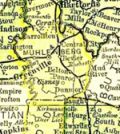Muhlenberg County Kentucky

Marriage Records
Divorces
W.T. Cardwell vs. Mollie E. Cardwell
Fannie S. Jackson vs. James Jackson
Edgar Noffsinger vs. Alma Noffsinger
Edgar Noffsinger filed suit for divorce from his wife, Alma Noffsinger. They were married, the petition states, on August 31, 1928, and separated October 7, 1932.
Source: The Greenville Leader January 4, 1935
Sylvester Reynolds vs. Elizabeth Reynolds
Sylvester Reynolds filed suit for divorce from his wife, Elizabeth Reynolds. They were married, according to the petition, on May 12, 1925, and separated in March, 1929.
Source: The Greenville Leader January 4, 1935
Kentucky Divorce Records
Source: Hogan, Roseann Reinemuth. Kentucky Ancestry: a Guide to Genealogical and Historical Research. Salt Lake City: Ancestry, 1992. Print.
In early Kentucky, from early statehood until the enactment of new legislation, the only way to obtain a divorce was by an act of the General Assembly. In 1809, a law authorized the circuit courts to grant divorces. However, divorces were still granted by legislative acts until 1849 when the state's third constitution prohibited such special legislation.
While an act of the legislature may seem to have made divorce all but impossible, recent analysis of divorce laws and practices in the antebellum South indicate that divorce may not have been as difficult to attain as previously thought.
Kentucky's divorce laws reflected the general attitude toward divorce that existed in the larger society. By a statute passed in 1809 by the Kentucky General Assembly, a man could obtain a divorce if the wife voluntarily left his “bed and board” for three years, if she lived with another man, or committed a felony. Determining the spouse at fault for the divorce was important since this had implications for remarriage and for division of any property the couple owned jointly or that was brought to the marriage.
By 1894, Kentucky statute provided for divorce to the wife in cases of (1) abandonment for one year; (2) habitual drunkenness for not less than one year; or (3) cruel beating or injury, attempt at injury, or probable danger to her life. Husbands were granted divorces in cases of (1) abandonment for one year; (2) habitual drunkenness for not less than one year; or (3) adultery by the wife or such lewd, lascivious behavior on her part as proves her to be unchaste without actual proof of an act of adultery.
Under the early statutes, the offending party could not remarry as long as the former spouse lived. The earliest law stated that the offending party could not be released from “the pains and penalties which the law prescribes against a marriage whilst a former husband or wife is living.” By 1873, divorced parties could remarry, but only one divorce was permitted to any person, except in those cases when the person was found not at fault for the divorce.
Availability of Divorce Records
Early divorces could be recorded in the Acts of Kentucky until as late as 1850. These early records are indexed in the Kentucky Historical Society (Frankfort, Kentucky) for the period 1792 to 1849.
Later divorce records may be found in the circuit court records in the county of residence, which will show a divorce as a chancery or equity case. Since July of 1958, divorces have been recorded in the Kentucky Office of Vital Statistics in Frankfort; copies of divorce decrees dating from 1958 can be obtained from that office.
Updated November 24, 2015